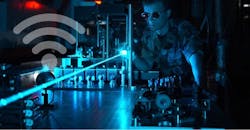Frequency combs trick a laser into producing/receiving an RF signal

In a paper published in the Proceedings of the National Academy of Sciences with the deceptively modest title “Radio frequency transmitter based on a laser frequency comb,” researchers from Harvard’s John A. Paulson School of Engineering and Applied Sciences (SEAS; Cambridge, MA) have demonstrated a laser that can emit encoded microwaves as wireless radio frequency (RF) signals, modulate them, and then receive/demodulate these same microwaves as external radio frequency signals.
Research into such electro-optical devices isn’t new to the lab headed by Federico Capasso, the Robert L. Wallace Professor of Applied Physics and Vinton Hayes Senior Research Fellow in Electrical Engineering at SEAS. In 2017, their researchers discovered that an infrared-frequency comb in a quantum cascade laser (QCL) could be used to generate terahertz frequencies, and in 2018, the team found that quantum-cascade laser-frequency combs could also act as integrated transmitters or receivers to efficiently encode information. Now, the researchers have developed a way to extract energy and then transmit it as wireless signals from laser frequency combs, and even perform the complementary receiver function.
The core building block for this advance is the QCL-based semiconductor-laser frequency comb, a structure whose output optical spectrum consists of a series of discrete, equally spaced frequency lines (note that Theodor W. Hänsch and John L. Hall shared half of the 2005 Nobel Prize in Physics for contributions to the development of laser-based precision spectroscopy, including the use of the optical frequency comb).
Within the laser, the different frequencies of light beat together to generate microwave radiation, very similar to the nonlinear mixing of paired signals widely used in audio through RF electronic systems. The light inside the laser cavity causes electrons to oscillate at microwave frequencies—here, around 5 GHz—which are within the standard communications spectrum, including a Wi-Fi band.
They were able to get the laser-radio-transmitter (LRT) arrangement to support energy radiation by redesigning the top contact of the laser and then using this internal oscillating current to drive an integrated dipole antenna that radiated it into free space. By modulating the laser current, they were able to directly encode an audio signal onto this carrier.
Of course, every transmitter needs a receiver to be useful, and the receiver can have an architecture that differs radically from the transmitter (and even be ignorant of it): Think of the superregenerative, superheterodyne, zero-IF, and software-defined radio (SDR) receiver approaches, none of which needs to resemble the topology of the signal-source transmitter. To initially validate the optical-to-RF approach, they received the signal using a horn antenna, then filtered it and sent it to a SDR for demodulation.
However, it would be even more attractive if the electro-optical transmitter could use a complementary receiver approach. The MIT team was able to do this using their configuration arranged where the antenna would receive the RF signal, then coupled it to laser’s active region and injection locked the laser. They actually tested this complete signal chain using a recording of legendary crooner Dean Martin singing his classic tune “Volare”!
Stepping back for a broader perspective, the researchers noted that the laser can be considered as a pairing of two RF sources, but of opposite phase. The top electrode of these lasers usually consists of an electrically continuous metal contact that connects the two generators, preventing the device from radiating.
Here, however, they showed that by changing the geometry of the top contact layer of a QCL, they could build and feed a dipole antenna integrated on the chip to enable emission of radio waves into free space. The frequency of the beat note can be tuned by modulating the laser current, and in this way, the laser takes on a new and unexpected role as a wireless radio transmitter (and even receiver) at a 5.5-GHz carrier frequency,
They remark that these results may point to new applications and functionality for integrated optical-frequency combs for wireless radio communication and wireless synchronization to a reference source. “The research opens the door to new types of hybrid electronic-photonic devices and is the first step toward ultra-high-speed Wi-Fi,” said professor Capasso.
SOURCE: ElectronicDesign online; https://www.electronicdesign.com/industrial-automation/laser-tricked-producing-receiving-modulated-wi-fi-band-rf-signals
About the Author

Gail Overton
Senior Editor (2004-2020)
Gail has more than 30 years of engineering, marketing, product management, and editorial experience in the photonics and optical communications industry. Before joining the staff at Laser Focus World in 2004, she held many product management and product marketing roles in the fiber-optics industry, most notably at Hughes (El Segundo, CA), GTE Labs (Waltham, MA), Corning (Corning, NY), Photon Kinetics (Beaverton, OR), and Newport Corporation (Irvine, CA). During her marketing career, Gail published articles in WDM Solutions and Sensors magazine and traveled internationally to conduct product and sales training. Gail received her BS degree in physics, with an emphasis in optics, from San Diego State University in San Diego, CA in May 1986.